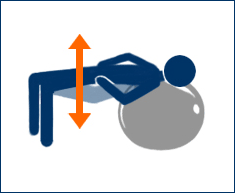Well, it depends. Is it acute pain that has only been bothering you for a few days or is it chronic, more like a few months?
Acute – usually defined as pain lasting less than 3 months, but also includes the pain that started this morning. For this type of pain, your first focus is to reduce inflammation (which includes your pain) and restore flexibility. Work out the kinks in muscle knots in your lower back and hips with pressure, massage, or stretching. Generally lower back pain is either worse in forward flexion or backwards extension. So, depending on the direction of less pain, focus your stretching more in flexion (pull knee to chest or lean forward to touch your toes) or extension (lean backwards, do the saggy push-up like the Cobra yoga position or at least sit with lumbar support from a towel or small pillow in the small of your back). Try to find positions of less pain, like lying on your back with your feet up on something or lying on your side with and pillow between your knees. Use ice for the pain, 15 minutes at a time followed by a chance to warm up the area completely, about 30 minutes. Pain killers and anti-inflammatory medications help some, but if the pain lasts more than 48 hours, consider seeing a Chiropractor for an assessment and treatment of the restricted joints and knotted muscles to relieve the nerve irritation.
Chronic – usually this is when your lower back pain has settled in for more than 3 months, either because you ‘thought it would go away’ or you’ve simply had no luck finding a treatment that helps. Many people have found those medications that can help more in the acute phase, are less likely to help now. You really need to find some exercise that helps restore mobility first, then work on improving your strength. Also, in this phase, you need to be patient. Some exercises might work, but you may not notice any improvement the first few times. Again, there is a preference for flexion or extension. Focus your exercises on the direction that is most comfortable. Either you flex like touching toes or pulling knee to chest or you extend like leaning backward or doing a Cobra position. Watch for slow progression here where over several days you may find you are getting slightly more flexible, that is good. If you are getting slightly more sore, that is not good. You may find a little pain while doing the exercises, that is normal, but it shouldn’t hurt more the next day. Other directions may also be stiffl, such as side bending or rotation. Both of these can be done while standing or sitting. While lying down, you are able to rotate by pulling one knee over to the opposite side slowly. You may also find relief by working on muscle knots that are causing pain. Either direct pressure with your thumb or a ball, or some type of massage, or try rolling on a foam roller or large yoga ball.
As the chronic pain decreases, you should start to rebuild the strength in the muscles of your lower back and hips. Most core strengthening exercises are good here, just be careful to start with easier exercises first. Try the Dead Bug where you lie on your back with your knees bent and your hips at 90 degrees and hands reaching up to the ceiling. Progress to Bridges, on your back with knees bent and feet flat on the floor (or bed), lift your hips up slowly and only as long as there is no pain.(the picture at the top of this article shows a bridge on a yoga ball) Later as you improve, Planks may be a good bet. All of these exercises need to be done cautiously, avoid painful things, and be patient.
If you find good relief from these measures, you are doing well. If not, consider seeing your Chiropractor for an assessment and likely some adjustments to restore normal mobility and function to your back and hips. It is also a good idea to have a professional check your on your choice of exercises and how to perform other household tasks without hurting yourself.



